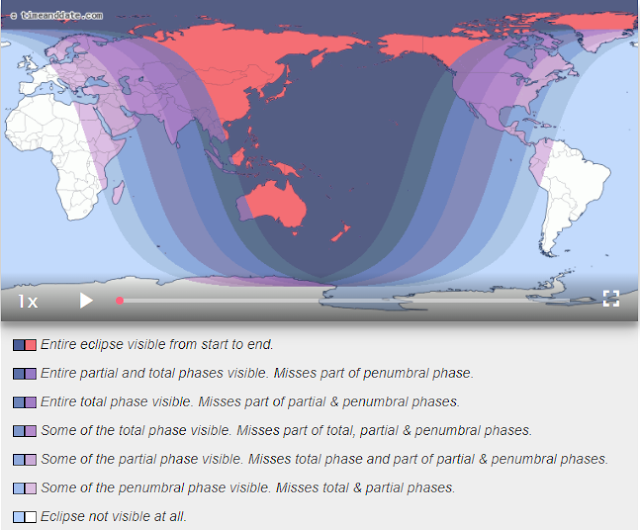The night sky throughout 2018 is going to be remarkable! We are going to be treated to a lunar eclipse, some close planetary conjunctions, the opposition of Mars and several comets worth checking out. In no particular order, I would like to cover some of the sights that I am excited for in the next twelve months.
Lunar Eclipse
We have not had a total lunar eclipse in Calgary since September of 2015. We will be treated to one during the morning of January 31, 2018. We will begin to see the partial eclipse begin at 4:48am with the total eclipse beginning just over an hour later at 5:51am. The total eclipse will last until 7:07am with the peak occurring at 6:29am.
This is Calgary's only eclipse of the year so it would be worth getting up early to watch this one. Assuming the sky is clear you'll be able to watch this eclipse as the Moon progresses to set in the West. The partial eclipse ends mere minutes before the Moon drops below the horizon. This may be ideal conditions for some great photographs.
Since this is the second Full Moon in the month of January it is also known as a 'blue moon'. However, this does not mean the Moon will appear blue, it will actually appear red. The Sun's light is refracted through the Earth's atmosphere to illuminate the Moon. Blue light gets scattered by the Earth's atmosphere leaving the red light transmitted through to the Moon.
 |
| Total Lunar Eclipse (Image Credit: NASA) |
I am certainly hoping the weather will be reasonable so I can obtain my own image of this event.
Planetary Conjunctions
There are several close planetary conjunctions happening throughout 2018. There will be more details about them as the time arrives. A list is provided below with images. The images have two circles at 1° and 4.4° (common field of view of telescope and binoculars).
January 7 - Jupiter/Mars
 |
| Jupiter/Mars Conjunction |
January 13 - Saturn/
Mercury
 |
| Saturn/Mercury Conjunction |
March 5 -
Venus/Mercury
 |
| Venus/Mercury Conjunction |
March 28 - Uranus/Venus
 |
| Uranus/Venus Conjunction |
April 2 - Saturn/Mars
 |
| Saturn/Mars Conjunction |
December 7 -
Neptune/Mars
 |
| Neptune/Mars Conjunction |
December 21 -
Jupiter/Mercury
 |
| Jupiter/Mercury Conjunction |
The Uranus/Venus conjunction at the end of March will be very close. However, it will also be close to the twilight. If you try to capture them in your telescope I wish you the best of luck. The Neptune/Mars conjunction during the middle of December is also going to be a particularly close one. Both planets easily fit inside the 1° circle. This will help you to find Neptune since it is now more than a basic field of view outside of its friend for the past couple years -- Lambda Aquarii.
Mars Opposition
This is a good news/bad news kind of situation. The good news is that Mars will be at its closest point to Earth during and will appear bright and large. However, its declination will be almost 20°S, straddling the southern sky. The atmosphere may interfere with good viewing for observers in northern latitudes. Also, a Full Moon occurs on the same day which will add a significant amount of light pollution to the sky. Its magnitude will be -2.8 and it will appear as a 24.2" disk. Mars spends most of its time as a tiny red dot barely noticed in the sky. Near opposition you have the opportunity to look through a telescope and see some of the terrestrial features on the diminutive planet. Even though it will be further away at its 2020 opposition us northerners may get a better view.
 |
| Mars Oppositions (Image Credit: Martin J Powell, www.nakedeyeplanets.com) |
Comets
There are a couple comets that I am interested in hunting down this year. Throughout September, Comet 21P/Giacobini-Zinner will be well positioned for a visual attempt. Also, a few months later, in December 46P/Wirtanen. 21P is predicted to reach a magnitude of around 6 which is easily reached in backyard telescopes or binoculars. 46P may even approach magnitude 3 which puts it within the realms of naked eye observation.
Of course there are many more sights that will be available for observers throughout 2018. Jupiter will have many double shadow transits of its moons across the planet's face in August. The annual
meteor showers will hopefully put on a show. The
Perseids occur during a New Moon and the
Geminids will peak after the waxing crescent Moon has set. This should provide some decent conditions to catch some 'shooting stars'.
There are also exciting transient events that may occur throughout each year. Supernovae from far away galaxies may become visible in telescopes, a bucket list item on many astronomers mind. You may catch a giant bolide
fireball explosion crossing the sky as a large meteor rains down on us. The
aurora is a flaky beast that provides little warning as to when it will appear. Monitor local solar forecasts to determine if you should head out to chase it!
All I can suggest is you keep your eyes on the sky and open your mind to the wonder of the universe.

































